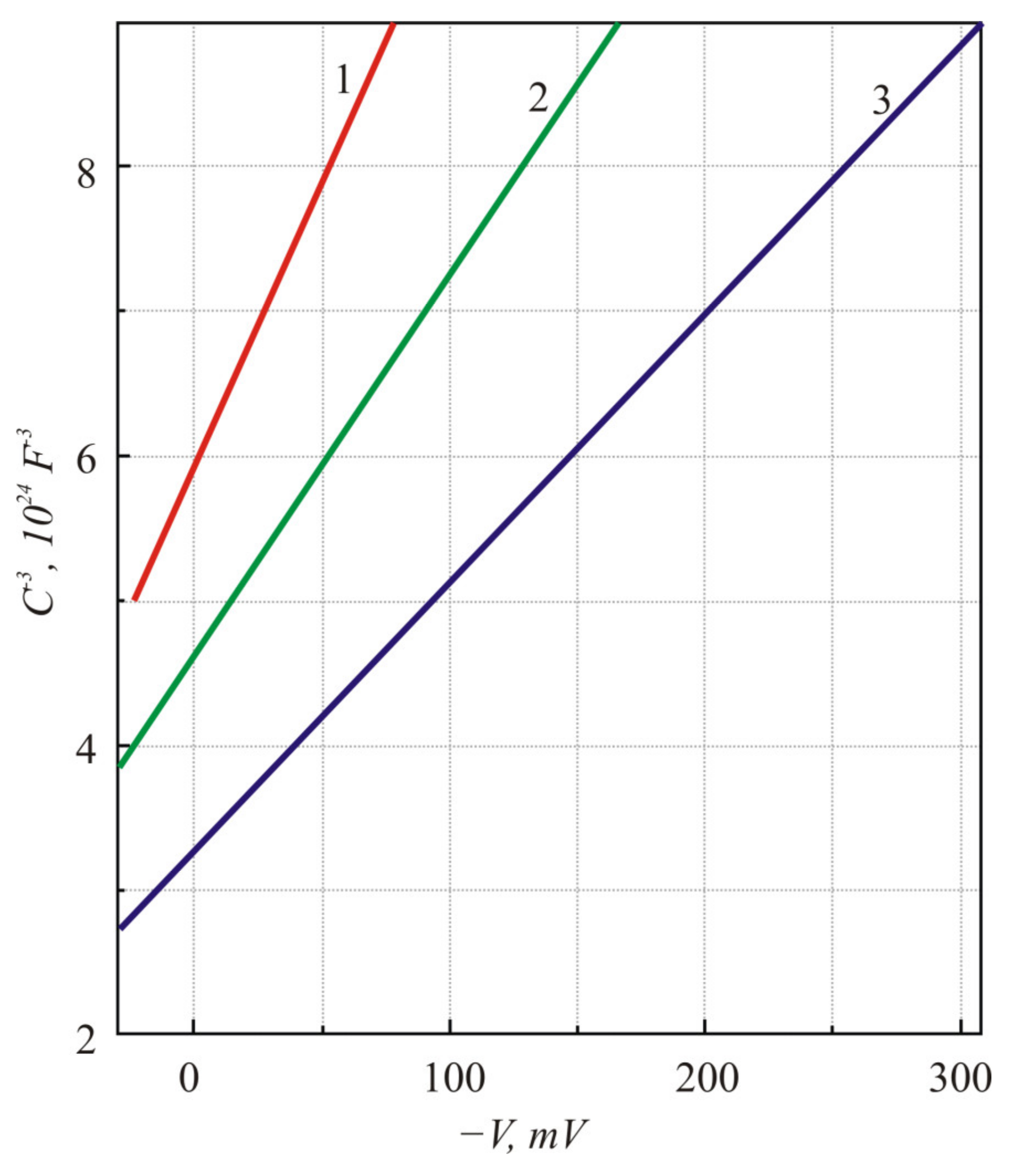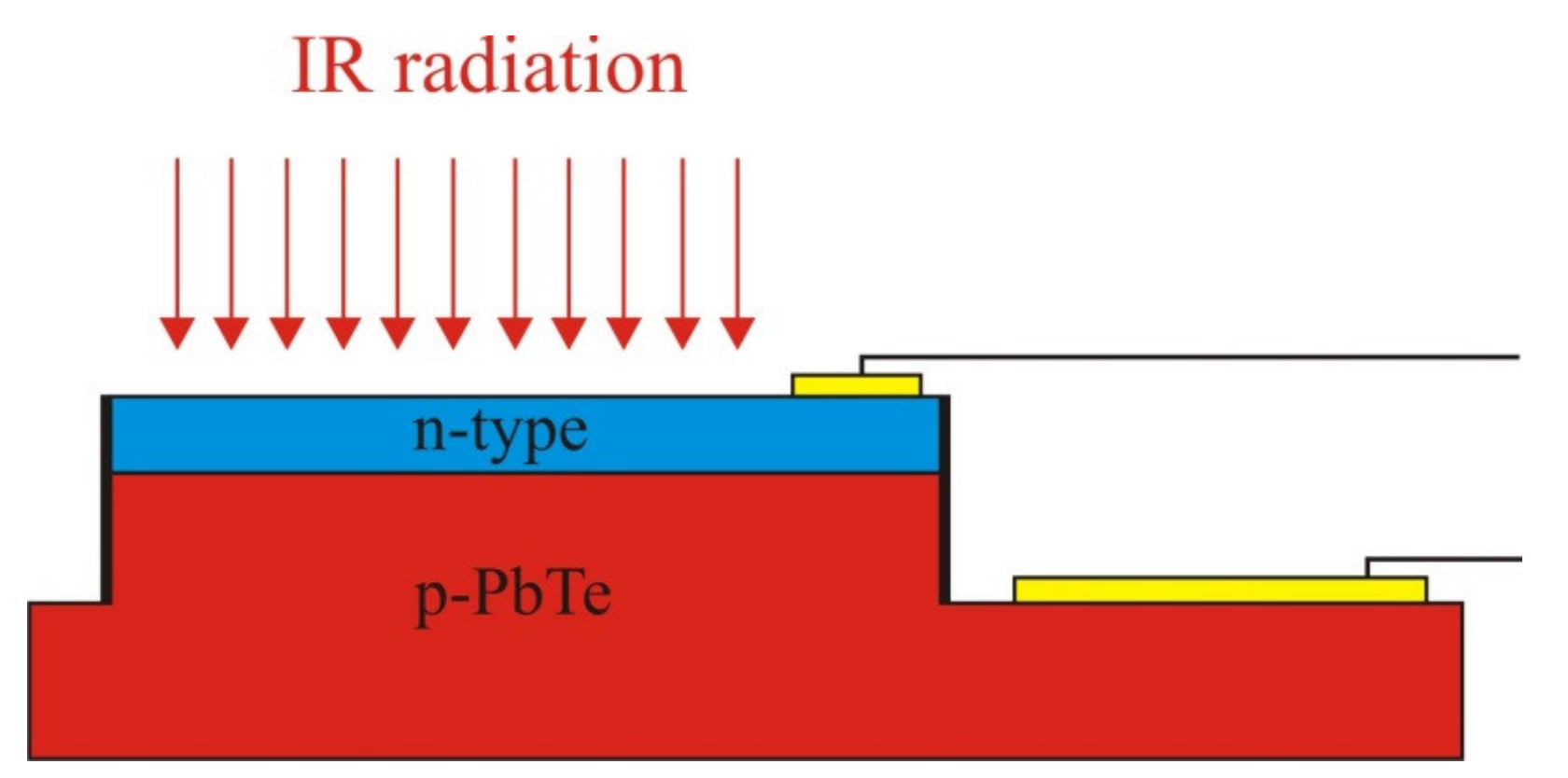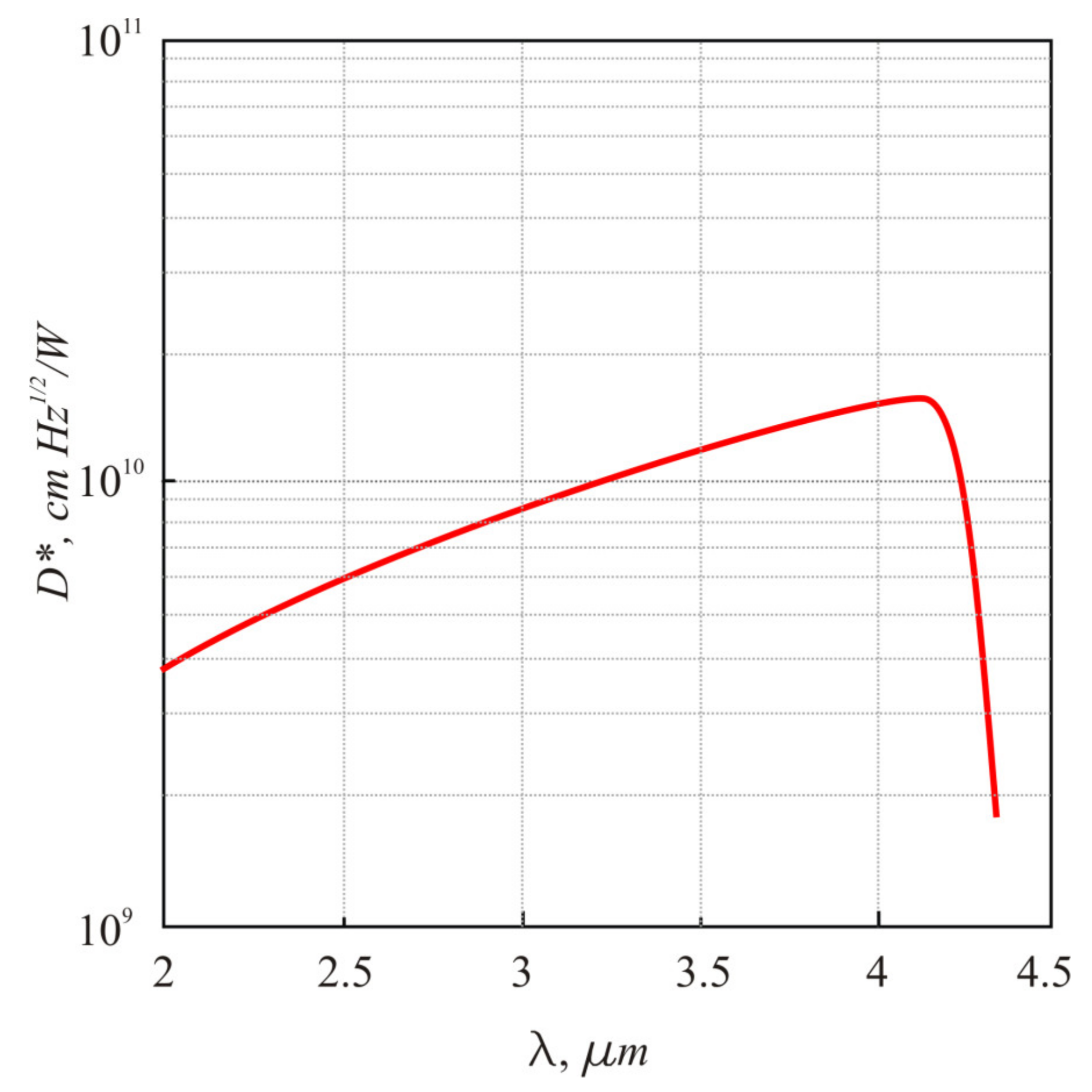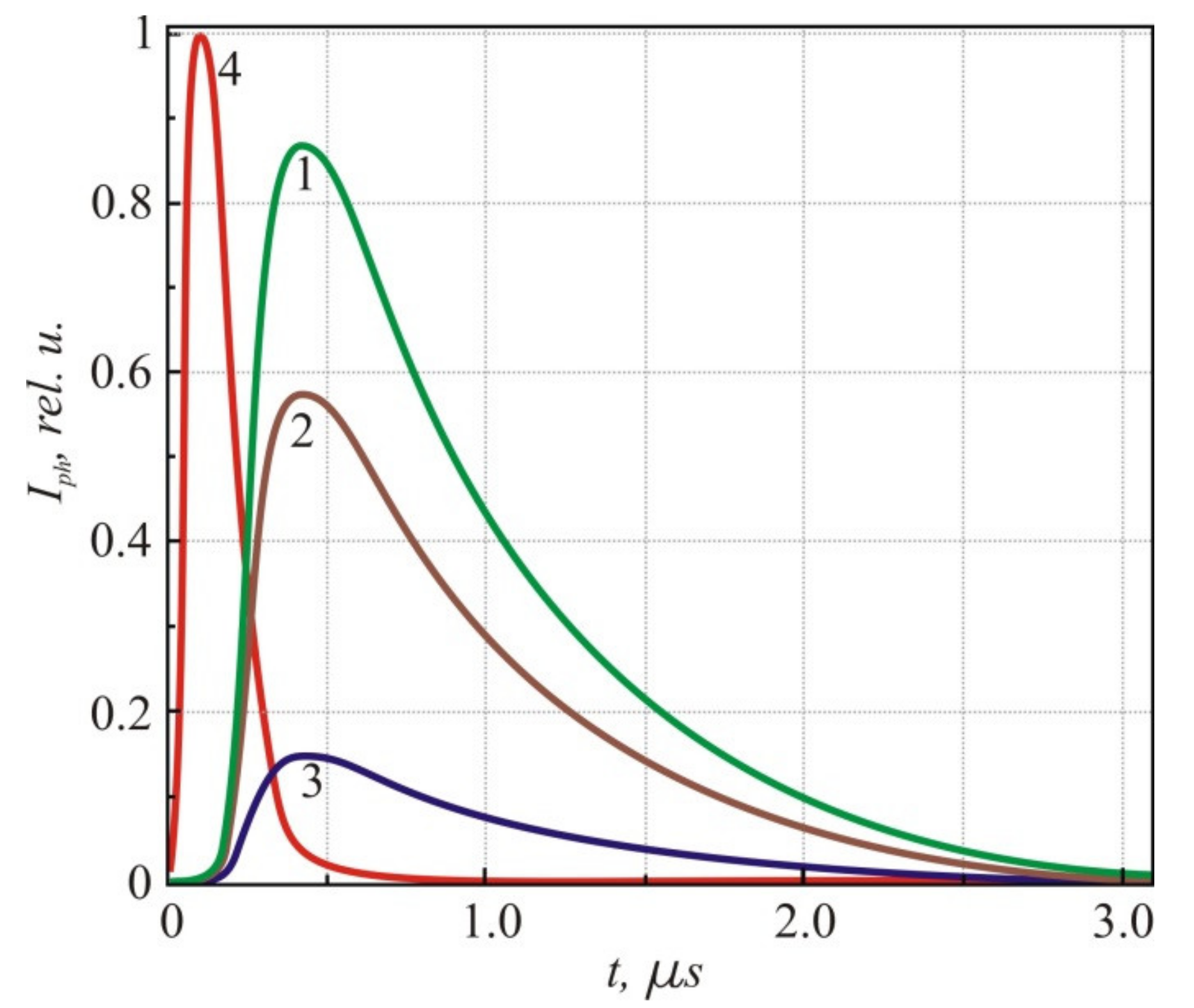Two-Color Infrared Sensor on the PbTe: In p-n Junction
Abstract
:1. Introduction
2. Detector Fabrication
3. Device Properties
3.1. Electrical Characteristics
3.2. Sensing Characteristics
4. Conclusions
Author Contributions
Funding
Institutional Review Board Statement
Informed Consent Statement
Conflicts of Interest
References
- Rogalski, A. Infrared detectors: Status and trends. Prog. Quantum Electron. 2003, 27, 59–210. [Google Scholar] [CrossRef]
- Fuchs, F.; Buerkle, L.; Hamid, R.; Herres, N.; Pletschen, W.; Sah, R.; Kiefer, R.; Schmitz, J. Optoelectronic properties of photodiodes for the mid-and far-infrared based on the InAs/GaSb/AlSb materials family. Proc. SPIE 2001, 4288, 171–182. [Google Scholar]
- Infrared Detectors. Hamamatsu. Selection guide. Available online: https://www.hamamatsu.com/resources/pdf/ssd/infrared_kird0001e.pdf (accessed on 12 December 2020).
- Ravich Yu, I.; Efimova, B.A.; Smirnov, I.A. Semiconducting Lead Chalcogenides; Plenum Press: New York, NY, USA, 1970. [Google Scholar]
- Khokhlov, D. Lead Chalcogenides. Physics and Application; Taylor & Francis: New York, NY, USA, 2003. [Google Scholar]
- Butenko, A.V.; Kahatabi, R.; Mogilko, F.; Strul, R.; Dashevsky, Z.; Kasiyan, V.; Genikov, S. Characterization of high temperature PbTe p-n junctions prepared by thermal diffusion and ion implantations. J. Appl. Phys. 2008, 103, 024506. [Google Scholar] [CrossRef] [Green Version]
- Zogg, H.; Fach, A.; Maissen, C.; Masek, J.; Blunier, S. Photovoltaic lead-chalcogenide on silicon infrared sensor arrays. Opt. Eng. 1994, 33, 1440–1449. [Google Scholar] [CrossRef]
- Barros, A.S.; Abramof, E.; Rappl, P.H.O. Electrical and optical properties of PbTe p-n junction infrared sensors. J. Appl. Phys. 2006, 99, 024904. [Google Scholar] [CrossRef] [Green Version]
- Yasuda, A.; Suto, K.; Takahashi, Y.; Nishizawa, J.I. Mid-infrared photoconductive properties of heavily Bi-doped PbTe p-n homojunction diode grown by liquid-phase epitaxy. Infrared Phys. Techn. 2014, 67, 609–612. [Google Scholar] [CrossRef]
- Fill, M.; Debernardi, P.; Felder, F.; Zogg, H. Lead-chalcogenide mid-infrared vertical external cavity surface emitting lasers with improved threshold: Theory and experiment. Appl. Phys. Lett. 2013, 103, 201120. [Google Scholar] [CrossRef]
- Zogg, H.; Arnold, M.; Felder, F.; Rahim, M.; Ebneter, C.; Zasavitskiy, I.; Quack, N.; Blunier, S.; Dual, J. Epitaxial lead chalcogenides on Si for mid-IR detectors and emitters including cavities. J. Electron. Mater. 2008, 37, 1497–1503. [Google Scholar] [CrossRef] [Green Version]
- Dariel, M.P.; Dashevsky, Z.; Jarashnely, A.; Shusterman, S.; Horowitz, A. Carrier concentration gradient generated in p-type PbTe crystals by unidirectional solidification. J. Cryst. Growth 2002, 234, 164–170. [Google Scholar] [CrossRef]
- Dashevsky, Z.; Kasiyan, V.; Mogilko, E.; Butenko, F. High-temperature PbTe diodes. Thin Solid Films 2008, 516, 7065–7069. [Google Scholar] [CrossRef] [Green Version]
- Dashevsky, Z.; Shusterman, S.; Dariel, M.P.; Drabkin, I. Thermoelectric efficiency in graded indium-doped crystals. J. Appl. Phys. 2002, 92, 1425–1430. [Google Scholar] [CrossRef]
- Sze, S.M. Physics of Semiconductor Devices, 2nd ed.; John Wiley and Sons: New York, NY, USA, 1981. [Google Scholar]
- Ma, J.; Chiles, J.; Sharma, Y.D.; Krishna, S.; Fathpour, S. Two-photon photovoltaic effect in gallium arsenide. Opt. Lett. 2014, 39, 5297–5300. [Google Scholar] [CrossRef] [PubMed]
- Kaidanov, V.I.; Ravich, Y.I. Deep and resonance states in AIVBVI semiconductors. Sov. Phys. Usp. 1985, 28, 31–53. [Google Scholar] [CrossRef]
- Akimov, B.A.; Dmirtiev, A.V.; Khokhlov, D.R.; Ryabova, L.I. A carrier transport and non-equilibrium phenomena in doped PbTe and related materials. Phys. Stat. Sol. 1993, 137, 9–55. [Google Scholar] [CrossRef]
- Belogorokhov, A.I.; Volkov, B.A.; Ivanchik, I.I.; Khokhlov, D.R. Model of DX-like Impurity Centers in PbTe (Ga). JETP Lett. 2000, 72, 123–125. [Google Scholar] [CrossRef]
- Volkov, B.A.; Ryabova, L.I.; Khokhlov, D.R. Mixed-valence impurities in lead telluride-based solid solutions. Phys. Usp. 2002, 45, 819–846. [Google Scholar] [CrossRef]
- Heremans, J.P.; Wiendlocha, B.; Chamoire, A.M. Resonant levels in bulk thermoelectric semiconductors. Energy Environ. Sci. 2012, 5, 5510–5530. [Google Scholar] [CrossRef]
- Wiendlocha, B. Fermi surface and electron dispersion of PbTe doped with resonant Tl impurity from KKR-CPA calculations. Phys. Rev. B. 2013, 88, 205205. [Google Scholar] [CrossRef] [Green Version]
- Parashchuk, T.; Dashevsky, Z.; Wojciechowski, K. Feasibility of a high stable PbTe:In semiconductor for thermoelectric energy applications. J. Appl. Phys. 2019, 125, 245103. [Google Scholar] [CrossRef]
- Parashchuk, T.; Sidorenko, N.; Sorokin, A.; Maksymuk, M.; Dzunzda, B.; Vichor, L.; Dashevsky, Z. Development of cryogenic thermoelectric cooler (CTEC). Cryogenics 2020. In press. [Google Scholar]








Publisher’s Note: MDPI stays neutral with regard to jurisdictional claims in published maps and institutional affiliations. |
© 2021 by the authors. Licensee MDPI, Basel, Switzerland. This article is an open access article distributed under the terms and conditions of the Creative Commons Attribution (CC BY) license (http://creativecommons.org/licenses/by/4.0/).
Share and Cite
Gradauskas, J.; Dzundza, B.; Chernyak, L.; Dashevsky, Z. Two-Color Infrared Sensor on the PbTe: In p-n Junction. Sensors 2021, 21, 1195. https://doi.org/10.3390/s21041195
Gradauskas J, Dzundza B, Chernyak L, Dashevsky Z. Two-Color Infrared Sensor on the PbTe: In p-n Junction. Sensors. 2021; 21(4):1195. https://doi.org/10.3390/s21041195
Chicago/Turabian StyleGradauskas, Jonas, Bohdan Dzundza, Leonid Chernyak, and Zinovy Dashevsky. 2021. "Two-Color Infrared Sensor on the PbTe: In p-n Junction" Sensors 21, no. 4: 1195. https://doi.org/10.3390/s21041195






